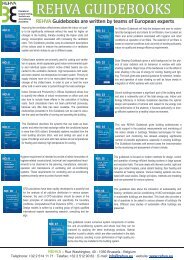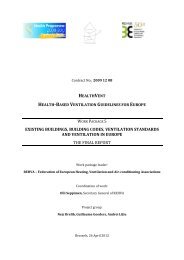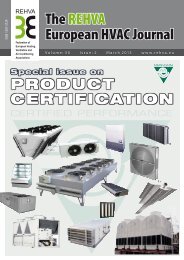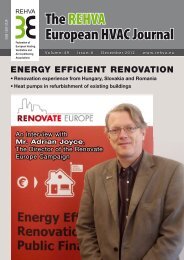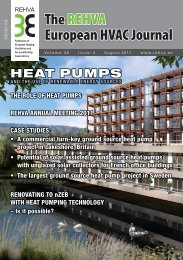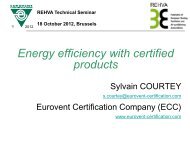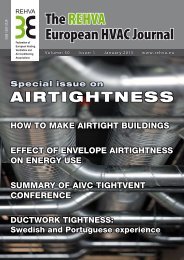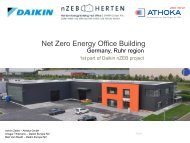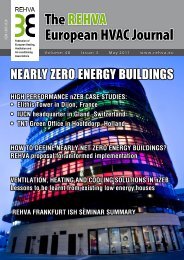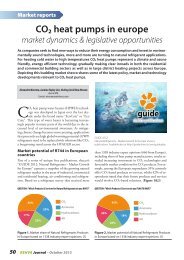Improved energy efficiency of air cooled chillers (PDF 387 kB) - rehva
Improved energy efficiency of air cooled chillers (PDF 387 kB) - rehva
Improved energy efficiency of air cooled chillers (PDF 387 kB) - rehva
You also want an ePaper? Increase the reach of your titles
YUMPU automatically turns print PDFs into web optimized ePapers that Google loves.
Articles<br />
Figure 5. Special diffuser<br />
for <strong>air</strong> fans.<br />
Hence we obtain significant results in <strong>energy</strong> saving<br />
as you trace the real load <strong>energy</strong> requirements without<br />
any additional loss or consumption being incurred by<br />
the process.<br />
To understand how the non-dissipative adjustment is<br />
able to act in this method, we can consider the operating<br />
curve <strong>of</strong> a centrifugal pump. (Figure 8)<br />
The intersection <strong>of</strong> the characteristic operating range for<br />
centrifugal pump with the typical flow-pressure curve<br />
can be used to identify the point <strong>of</strong> working regime<br />
(point A for 100% <strong>of</strong> load). If the load in the system requires<br />
a flow <strong>of</strong> 75% <strong>of</strong> the maximum by the regulation<br />
by the classic choke valve installed after the pump then<br />
an additional pressure drop is artificially introduces and<br />
the system must overcame a higher pressure drop (kPa<br />
or m.w.c.) than is actually required by load (point B).<br />
Furthermore by moving the operating flow point, the<br />
pump <strong>efficiency</strong> is also changed, which then introduces<br />
a further <strong>efficiency</strong> loss.<br />
By adjusting inverter frequency instead, it follows the<br />
real load demand by altering the pump curve. (Figure 9).<br />
Varying the speed <strong>of</strong> the pump changes its actual operating<br />
curve, which will move vertically downwards and<br />
thus we reach into the new operating point (point C)<br />
without any adjustment valve introduction. This results<br />
in a real <strong>energy</strong> saving <strong>of</strong> 30%.<br />
The process pumps when installed with an inverter can<br />
effectively have zero starting current if the water flow<br />
can be gradually increased up to the maximum flow,<br />
which again avoids potentially water hammer. The correct<br />
management <strong>of</strong> the inverter location completes the<br />
full system optimization.<br />
Conclusion<br />
Figure 6. Inverter driven<br />
Figure 7. Electrical board<br />
double pump.<br />
140<br />
with inverters for pumps.<br />
120<br />
B<br />
140<br />
140 140<br />
A<br />
120 100<br />
120<br />
B<br />
120<br />
B<br />
B<br />
A<br />
A<br />
A<br />
100 80<br />
100 100<br />
80 60<br />
80 80<br />
60 40<br />
60 60<br />
2040<br />
40<br />
200<br />
20 20<br />
0<br />
000<br />
20 40 60 80 100 120 140<br />
0<br />
0 0 20<br />
20<br />
40 20 40<br />
60<br />
60 Flow 40 rate<br />
80<br />
80 [%]<br />
100<br />
100 60 120<br />
120 80 140<br />
140 100<br />
Flow rate [%]<br />
Flow rate [%] Flow rate [%]<br />
Resistance curve at 100% Resistance curve at partial load Pump curve<br />
Resistance<br />
Resistance Resistance curve at 100%<br />
curve 100% curve Resistance at Resistance 100% curve at partial<br />
curve at partial Resistance load Pump<br />
load Pump curve<br />
curve at partial load<br />
Figure 8. Operating curve <strong>of</strong> a centrifugal pump. <br />
<br />
140<br />
Head Head pressure pressure [%] [%]<br />
Head pressure [%]<br />
Head pressure [%]<br />
140 140 140 120<br />
120 120 120 100<br />
B<br />
A<br />
B<br />
A<br />
100 100 100 80<br />
C<br />
80 8060<br />
80<br />
C<br />
60 6040<br />
60<br />
40 4020<br />
40<br />
20 20 20 0<br />
0 0<br />
0 20 40 60 80 100 120 140<br />
0<br />
0 0 20<br />
20<br />
40 20 40<br />
60<br />
60 4080 Flow rate 80[%]<br />
100<br />
100 60 120<br />
120 80 140<br />
140 100<br />
Flow rate [%]<br />
Flow rate [%] Flow rate [%]<br />
Resistance curve at 100% Pump curve at 100% Pump curve at reduced speed<br />
Resistance Resistance curve at 100% curve Resistance at 100% curve at partial Resistance load Pump curve at partial load<br />
Figure Resistance 9. curve Operating 100% curve Pump curve with at 100% speed Pump pump curve variation.<br />
at reduced speed <br />
<br />
<br />
Head pressure [%]<br />
Head pressure [%]<br />
Head pressure [%]<br />
Today there are many applications that require effective<br />
and innovative solutions to reduce the absorbed<br />
powers requirements <strong>of</strong> refrigeration hardware in process<br />
cooling industries, commercial <strong>air</strong> conditioning and<br />
data centres facilities. The optimum operation <strong>of</strong> refrigeration<br />
equipment at partial loads is especially significant<br />
in condition where the medium annual ambient<br />
<strong>air</strong> temperatures are between +5°C and +20°C, typical<br />
for the vast majority <strong>of</strong> European conditions. For<br />
even lower ambient temperatures the combination <strong>of</strong><br />
inverter technology coupled with that <strong>of</strong> free-cooling,<br />
whereby chilled water can be produce using only fans<br />
<strong>energy</strong>, can be effectively used to produce chiller units<br />
with even greater efficiencies than previously considered<br />
possible.<br />
REHVA Journal – January 2013 53



